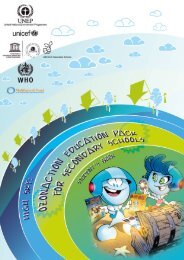Chapter 2. Progress towards the EFA goals - Unesco
Chapter 2. Progress towards the EFA goals - Unesco
Chapter 2. Progress towards the EFA goals - Unesco
Create successful ePaper yourself
Turn your PDF publications into a flip-book with our unique Google optimized e-Paper software.
PROGRESS TOWARDS THE <strong>EFA</strong> GOALS<br />
Estimating <strong>the</strong> cost of achieving Education for All<br />
International evidence on <strong>the</strong> incremental costs<br />
that might be associated with creating a highquality<br />
learning environment is more fragmented<br />
and inconsistent (Chanamuto, 2009). Getting<br />
teachers to schools in remote rural areas, slums<br />
and o<strong>the</strong>r marginalized environments requires<br />
incentives, but on what scale? Providing<br />
schooling to children whose lives have been<br />
blighted by poverty, hunger, stigmatization and<br />
low expectations is likely to require<br />
supplementary teaching and additional teaching<br />
materials, but <strong>the</strong>re is no established benchmark<br />
for estimating <strong>the</strong> additional financing required.<br />
For <strong>the</strong> purposes of <strong>the</strong> costing exercise,<br />
three criteria are used to introduce equity-based<br />
finance:<br />
Assessing <strong>the</strong> size of <strong>the</strong> school age population<br />
requiring additional support. Drawing on a new<br />
statistical source – <strong>the</strong> Deprivation and<br />
Marginalization in Education (DME) data set<br />
introduced in <strong>Chapter</strong> 3 – <strong>the</strong> Report establishes,<br />
for each country, <strong>the</strong> share of <strong>the</strong> population<br />
aged 17 to 22 with fewer than four years in<br />
school. This is used as a proxy indicator for <strong>the</strong><br />
proportion of <strong>the</strong> school age population that is<br />
marginalized and in need of additional incentives<br />
and school resources to participate in basic<br />
education. There are obvious limitations to this<br />
measure, including <strong>the</strong> fact that it captures past<br />
outcomes ra<strong>the</strong>r than <strong>the</strong> current situation.<br />
However, <strong>the</strong> four-year benchmark is a useful<br />
measurement of <strong>the</strong> scale of marginalization.<br />
<strong>Chapter</strong> 3 explores <strong>the</strong> use of this measure<br />
of marginalization in greater detail.<br />
Table <strong>2.</strong>10: Costs of achieving Education for All in low-income countries<br />
US$ billions (constant 2007 prices)<br />
Current domestic resources (circa 2007)<br />
Cumulative cost (2008-2015)<br />
Average annual cost (2008-2015)<br />
Pre-primary<br />
Primary<br />
Providing incentives for marginalized children.<br />
The costing exercise includes financial provision<br />
for incentives aimed at marginalized groups.<br />
It assumes a cost per child of 5% of GDP per capita<br />
for primary school students and 7.5% for lower<br />
secondary school students.<br />
Creating an incremental financing coefficient.<br />
There are no ready-made standards that can be<br />
applied on a cross-country basis. For <strong>the</strong> purposes<br />
of <strong>the</strong> costing exercise, <strong>the</strong> cost parameter for<br />
reaching <strong>the</strong> marginalized is set at an increment of<br />
33% above average recurrent costs. This is broadly<br />
consistent with <strong>the</strong> sparse evidence available on<br />
<strong>the</strong> cost of financing teacher incentives and o<strong>the</strong>r<br />
measures to bring good-quality education to<br />
marginalized children (Chen and Mulkeen, 2008;<br />
Mulkeen, 2009a).<br />
The global cost<br />
The aggregate costs that emerge from <strong>the</strong> analysis<br />
are anchored in national data for <strong>the</strong> forty-six<br />
low-income countries covered. 60 For each of<br />
<strong>the</strong> Education for All targets selected, <strong>the</strong> norms<br />
for education inputs are applied to <strong>the</strong> size of <strong>the</strong><br />
population that has to be reached in each country.<br />
This makes it possible to identify <strong>the</strong> number of<br />
teachers, additional classrooms and teaching<br />
materials required. The cost parameters for<br />
<strong>the</strong>se inputs are <strong>the</strong>n applied, with adjustments<br />
for reaching <strong>the</strong> marginalized. Table <strong>2.</strong>10 shows<br />
<strong>the</strong> resulting cost projections. To summarize:<br />
Cumulative costs over 2008–2015 for <strong>the</strong><br />
basic education <strong>goals</strong> run to US$286 billion,<br />
or US$36 billion annually (in constant 2007 US$).<br />
Current spending on basic education is about<br />
Adult<br />
literacy*<br />
Basic education<br />
sub-total<br />
Lower<br />
secondary<br />
Total<br />
0.8 11.1 – 11.9 4.7 16.6<br />
60.4 220.4 5.1 285.9 120.2 406.1<br />
7.5 27.5 0.6 35.7 15.0 50.7<br />
The financing<br />
required to<br />
achieve <strong>the</strong> basic<br />
education <strong>goals</strong> is<br />
more than double<br />
current levels<br />
of spending<br />
Breakdown of costs between 2008-2015 (%)<br />
Teachers<br />
Classroom construction<br />
Programmes to reach <strong>the</strong> marginalized<br />
O<strong>the</strong>r<br />
39 40 – 40 36 39<br />
41 27 – 30 30 30<br />
– 14 – 11 12 11<br />
20 20 – 20 22 21<br />
Notes: Breakdown of costs for basic education subtotal relates only to pre-primary and universal primary education. Subtotals are based on non-rounded figures.<br />
* The estimated adult literacy costs for <strong>the</strong> low-income countries covered are about three times <strong>the</strong> costs estimated in <strong>the</strong> original study (see Van Ravens and Aggio, 2005).<br />
Source: EPDC and UNESCO (2009).<br />
60. The base year is 2007<br />
and estimates are based on<br />
<strong>the</strong> 2008–2015 period unless<br />
o<strong>the</strong>rwise indicated.<br />
125
















